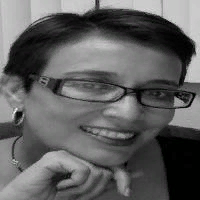
Leticia Ortega Maynez
Work place: UACJ/Department of physics and mathematics, Juarez, Mexico
E-mail: lortega@uacj.mx
Website:
Research Interests: Medical Image Computing, Image Processing, Image Manipulation, Image Compression, Medical Informatics
Biography
Leticia Ortega Maynez was born in Chihuahua City, state of Chihuahua, north of México. She received the B.Eng. in industrial electronics from the Technological Institute of Chihuahua. She received the M.Sc. degree on electronics at the same Institution, with the research Classification of Digital Mammograms into Normal and Abnormal System. In 1998 she was awarded with the Chihuahua prize given by the Chihuahua State Government for the research Classification of digital mammograms system into normal and abnormal through the texture analysis and micro-calcification detection. In 2009 she finished her Ph.D. at the University of Manchester United Kingdom, with the research thesis Image reconstruction and data correction for very high-resolution pre-clinical positron emission tomography with the quad-HIDAC PET system. Since 1998 she has been working for the Universidad Autonoma de Ciudad Juarez as a professor researcher, focusing her investigations on 3D image reconstruction and digital image processing of medical images.
Author Articles
Super Resolution of PET Images using Hybrid Regularization
By Jose Mejia Boris Mederos Liliana Avelar-Sosa Leticia Ortega Maynez
DOI: https://doi.org/10.5815/ijigsp.2017.01.01, Pub. Date: 8 Jan. 2017
Positron emission tomography images are used to diagnose, staggering, and monitoring several diseases like cancer and Alzheimer, also, this technique is used in clinical research to help to assess the therapeutic and toxic effects of drugs. However, a main drawback of this modality is the poor spatial resolution due to limiting factors such as positron range, instrumentation limits and the allowable doses of radiotracer for administration to patients. These factors also lead to low signal to noise ratios in the images. In this paper, we proposed to increment the resolution of the image and reduce noise by implementing a super resolution scheme, we proposed to use a hybrid regularization consisting of a TV term plus a Tikhonov term to solve the problem of low resolution and heavy noise. By using an anatomical driven scheme to balance between regularization terms we attain a better resolution image with preservation of small structures like lesions and reduced noise without blurring the edges of images. Experimental results and comparisons with other methods of the state-of-the-art show that our proposed scheme produces better preservation of details without adding artifacts when the resolution factor is increased.
[...] Read more.Other Articles
Subscribe to receive issue release notifications and newsletters from MECS Press journals